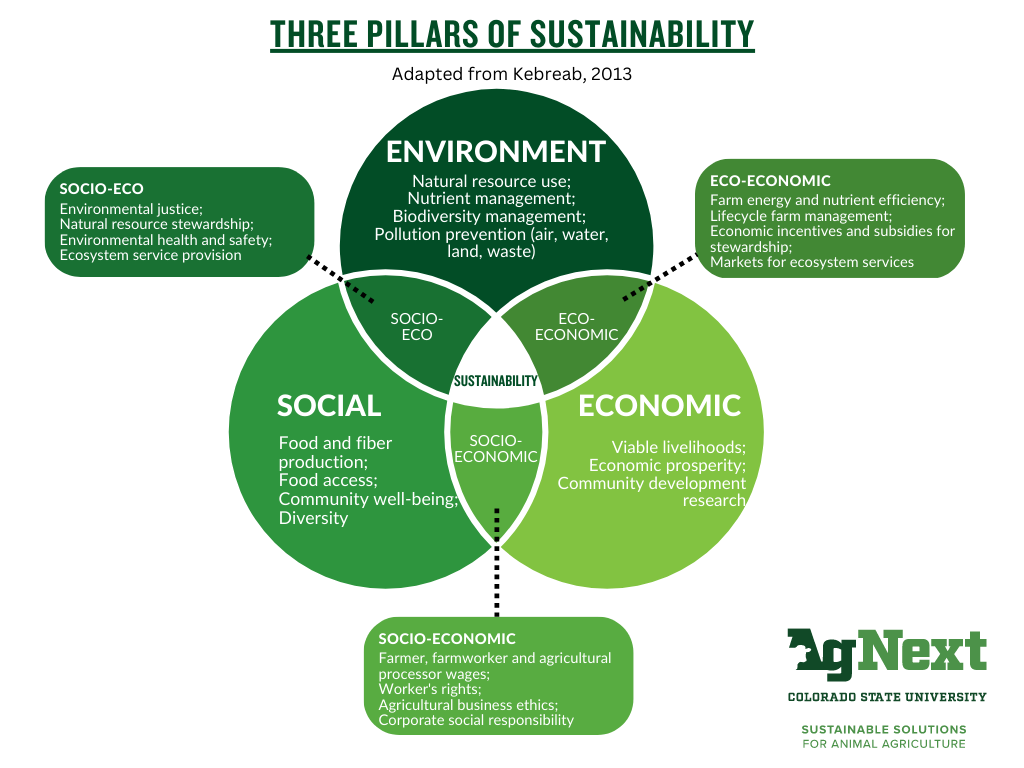Authored by: Samantha Clark, Logan Thompson Ph.D., and Kim Stackhouse-Lawson Ph.D.
Sustainability Defined
Sustainability is a term used across many industries, and it has increased in interest and research over the last 40 years. However, the complex nature of sustainability and its varying interpretations makes a definitive definition elusive. In the broadest of terms, it can be defined as meeting the needs of the society today without compromising the ability of future generations to meet their needs (EPA, 2021). Over the past decade, the most commonly cited definitions of sustainability have advanced to include the three pillars: social, economic and environmental. At CSU AgNext, we define sustainability as continuously improving social, economic and environmental stewardship of the animal agriculture system.
Defining the Three Pillars
Sustainability is a balance between these three pillars: social, economic and environmental (Kebreab, 2013). Each pillar addresses different topics that should be considered in a holistic analysis of sustainability. Those topics include:
- Social pillar: community well-being, diversity, food access and culture
- Economic pillar: profitability, quality standard of living, business growth, economic prosperity and food cost
- Environment pillar: natural resource use, nutrient cycling, biodiversity management and pollution prevention
Without a balance between all of these topics, animal agriculture will not be sustainable.

A Complex System
Due to the complexity and importance of animal agriculture systems, we must consider interactions and potential unintended consequences of solutions towards enhanced sustainability. Sustainability may be best described as a “wicked” problem as no definitive formulation of the problem exists. It does not have one solution and stakeholders often have different frames of reference or perspectives (Kebreab, 2013). An integrated science-based approach is necessary when assessing sustainability, where multiple aspects of the system should be considered to understand the tradeoffs when the system is altered. For example, those solutions developed to reduce greenhouse gas emissions should only be implemented if they do not sacrifice (and ideally improve) different ecosystem elements. Those elements include land, air and water quality, water use, food security, animal health and well-being, worker safety and satisfaction, impacts on public health, racial and gender equality and value chain profitability.
In Summary
- We define sustainability as continuously improving social, economic and environmental stewardship of the animal agriculture system.
- Due to the complexity of animal agriculture systems, there are different perspectives and approaches without one perfect solution, creating difficult discussions toward how to develop a more sustainable food system.
- An integrated science-based approach is necessary when assessing sustainability, where multiple aspects of the system should be considered to understand the tradeoffs when the system is altered.
Sources:
EPA. Sustainability Primer. EPA.gov. Available from: https://www.epa.gov/sites/production/files/2015-05/documents/sustainability_primer_v9.pdf
Kebreab, E. 2013. Sustainable Animal Agriculture. CABI.
EPA. 2021. Sustainability and the ROE. Available from: https://www.epa.gov/report-environment/sustainability-and-roe
